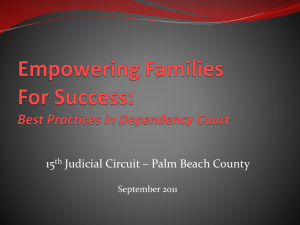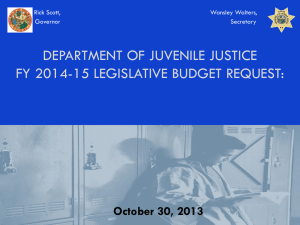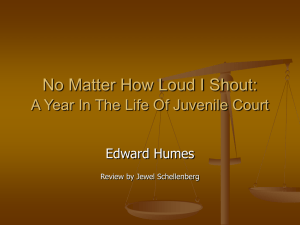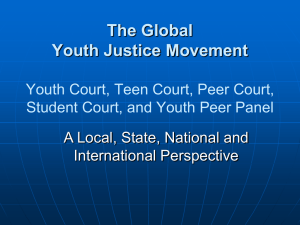Juvenile-Justice-Case-Studies-Handout
advertisement
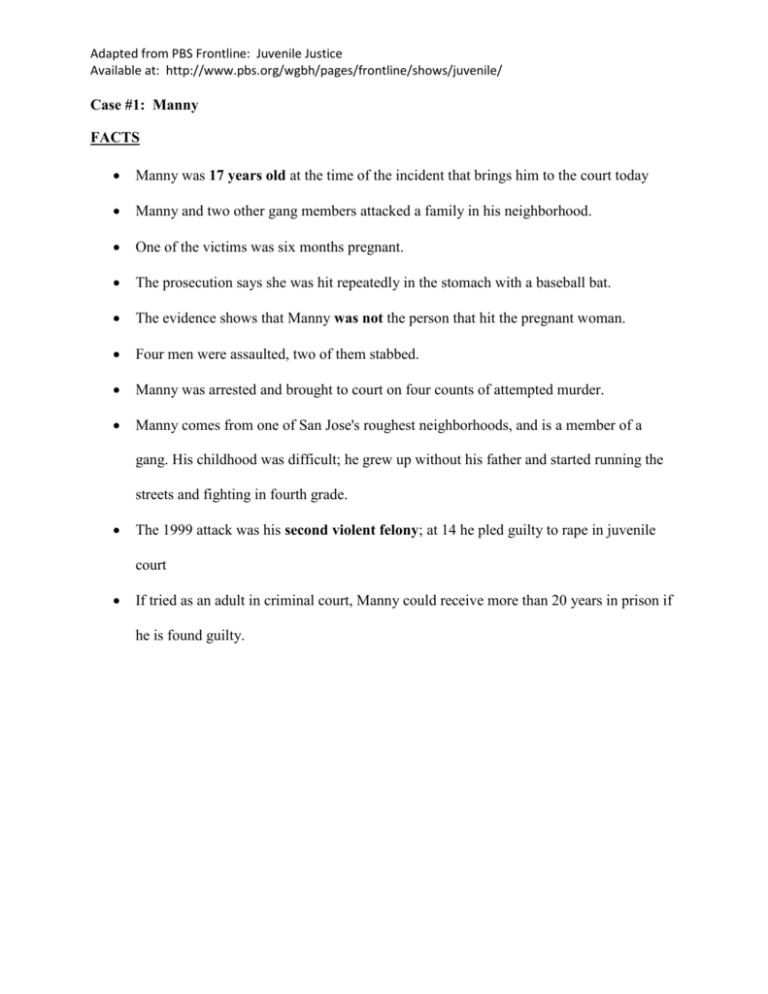
Adapted from PBS Frontline: Juvenile Justice Available at: http://www.pbs.org/wgbh/pages/frontline/shows/juvenile/ Case #1: Manny FACTS Manny was 17 years old at the time of the incident that brings him to the court today Manny and two other gang members attacked a family in his neighborhood. One of the victims was six months pregnant. The prosecution says she was hit repeatedly in the stomach with a baseball bat. The evidence shows that Manny was not the person that hit the pregnant woman. Four men were assaulted, two of them stabbed. Manny was arrested and brought to court on four counts of attempted murder. Manny comes from one of San Jose's roughest neighborhoods, and is a member of a gang. His childhood was difficult; he grew up without his father and started running the streets and fighting in fourth grade. The 1999 attack was his second violent felony; at 14 he pled guilty to rape in juvenile court If tried as an adult in criminal court, Manny could receive more than 20 years in prison if he is found guilty. Adapted from PBS Frontline: Juvenile Justice Available at: http://www.pbs.org/wgbh/pages/frontline/shows/juvenile/ Case #1: Manny Outcome Ultimately, the court agreed. Despite evidence that Manny had not been the one to hit the pregnant woman, Judge LaDoris Cordell found him unfit on the final criterion, the seriousness of the crime. In her ruling, she said, "There is no evidence of any circumstances that would tend to mitigate the gravity of the offense. It was clearly under any kind of reading a vicious attack." Under California law, since Manny was 17, he must be sent to adult court if found unfit on any of the five criteria. His one reprieve was being allowed to stay in Juvenile Hall pending the outcome of his adult trial. In the summer of 2000, Manny pled guilty to seven counts of assault with a deadly weapon. He now has two adult violent felony convictions or "strikes." If he commits another felony--violent or nonviolent -- he could be sentenced to life in prison under California's "three strikes" law. He is not hopeful about his chances of remaining out of prison for life. He says, "It might as well be a done deal. Two strikes. . . . I am only 18 years old. I plan to live until I am 50, I'm not perfect. I don't know, I don't think I'm going to make it, you know? I don't think I'm going to stay out for good." On January 22, 2001, Manny was sentenced to nine years at state prison. Adapted from PBS Frontline: Juvenile Justice Available at: http://www.pbs.org/wgbh/pages/frontline/shows/juvenile/ CASE #2: SHAWN FACTS 16 year-old Shawn attacked his sleeping father on Christmas night, stabbing him repeatedly in the arms, head and neck with a knife. The reason for the attack remains unclear. Shawn himself claims to have no memory of stabbing his father. A psychiatrist said the attack stemmed from "an altered state of consciousness" coming from "a disturbance of sleep." Shawn could have been sleep walking. Prior to this incident Shawn was arrested and charged with strong-arm robbery when he and a friend stole money from a smaller boy. Shawn also said that his drinking had escalated into serious marijuana use, and that he was expelled from two schools. Shawn had a troubled home life. His mother had a drinking problem and introduced Shawn to drinking at an early age. His father was often away on business trips, leaving Shawn and his mother alone. Shawn was charged with attempted murder. The judge postponed Shawn’s case so that Shawn could undergo a 90 day evaluation at the state's most restrictive juvenile detention facility. During his first week there, Shawn committed a sex crime against his cell mate. If convicted in adult court of attempted murder, Shawn would have faced a mandatory sentence of 15 years to life. Adapted from PBS Frontline: Juvenile Justice Available at: http://www.pbs.org/wgbh/pages/frontline/shows/juvenile/ CASE #2: SHAWN OUTCOME When Shawn returned, Judge Edwards handed down a sentence that surprised some people in court. After the incident with his cellmate, it seemed likely that Shawn would receive at least some time in the California Youth Authority. However, Judge Edwards ruled that Shawn remain in the Santa Clara County's Juvenile Hall until he turns 19. In addition, Shawn would be allowed to leave the facility during the day to attend community college classes, private counseling sessions, and Narcotics Anonymous meetings. Eventually he was even allowed to go home for meals with his family. The prosecutor was surprised, and troubled, by the outcome. He said, "At the end, I think everyone in that courtroom was ready to fall out of their chairs. And I think that it was a tremendous injustice that was done in this case. Not just the fact that we didn't treat this individual the way that he should have been treated - in my opinion - but that we have created the perception in the community that certain people are going to be treated differently in the system, because of where they come from." He is not the only one. Many of the kids serving time in Juvenile Hall think Shawn got a break, and that had he not been white and from an affluent neighborhood, he would have received a much harsher sentence. Even his attorney Bridgett Jones says that this case reminds her: "There is inequity in the juvenile justice system . . . . There is inequity in terms of race, there is inequity in terms of socioeconomic status. . . . You know it and you see it, but to actually have a case like this, it really brings it to the forefront." Whether Shawn will take advantage of the break he has been given remains to be seen. At the end of October he got into trouble again--he smoked pot. When he thought his probation officer knew and had proof, he took off. When he was arrested four hours away in another town, he was high and belligerent, and officers had to use force to restrain him. In February Judge Edwards is due to sentence him for the probation violation. He can send him to the California Youth Authority, or sentence him to additional time in a local facility. Adapted from PBS Frontline: Juvenile Justice Available at: http://www.pbs.org/wgbh/pages/frontline/shows/juvenile/ CASE #3: MARQUESE FACTS Marquese is 17 years old and is what members of the juvenile justice system call a "frequent flyer." Marquese will be 18 years old in 2 months. Marquese has seven juvenile felony convictions, all theft-related. Marquese has been on probation and spent time in juvenile hall, at the juvenile camp, and at the California Youth Authority. He is in your court today because he is charged auto theft and residential burglary. Marquese has been described as a career criminal who despite receiving multiple rehabilitative services over the years continues to break the law as soon as he is released from detention. Other people believe Marquese can be helped. Marquese is very bright, and has does well when he is in an institutional setting: he does not cause trouble, does his school work, and does not participate in gang activities. These supporters believe Marquese reoffends when he is released because he is not given adequate support and supervision. The most stable environments he ever had were in institutions. Marquese's mother has serious substance abuse problems, and some of Marquese's younger siblings had been temporarily removed from her care by the state. Her drugs of choice were heroin and crack cocaine. At the fitness hearing, a probation officer described their home as "a crack house." Adapted from PBS Frontline: Juvenile Justice Available at: http://www.pbs.org/wgbh/pages/frontline/shows/juvenile/ CASE #3: MARQUESE OUTCOME Judge Nancy Hoffman eventually determined that Marquese should get one more chance at rehabilitation in the juvenile system. Since he was charged with a nonviolent felony, in order to be transferred to the adult system, Judge Hoffman could not find him unfit based on just one criterion. She could only send him to adult court if she found him unfit overall, weighing all the criteria set out by California law: the level of the offender's criminal sophistication, whether the minor can be rehabilitated within the time the juvenile system has jurisdiction over him or her, previous delinquent history, the success of prior attempts at rehabilitation, and, finally, the seriousness of the crime. Hoffman found that he was unfit under the first criterion of criminal sophistication, since he had planned the burglary. She also found him unfit in terms of his prior record of rehabilitation within the juvenile system, since he had reoffended so often after treatment. However, she found him fit under the remaining three criteria. In terms of his prior history she found that his criminal history was mitigated by his "horrendous childhood" during which he received "little or no guidance," and was therefore fit under that criterion. On the fifth criteria, the gravity of the offense, she found him fit. Therefore, Judge Hoffman ruled that he was still amenable to treatment within the juvenile system. Marquese was returned to the California Youth Authority and will be up for parole in the fall of 2001. Adapted from PBS Frontline: Juvenile Justice Available at: http://www.pbs.org/wgbh/pages/frontline/shows/juvenile/ CASE #4: JOSÉ FACTS In the fall of 1998 15 year old José participated in a deadly brawl. He and four other teenagers -- two of them recent immigrants from Mexico - had been hanging out in an alley, drinking. Evidence shows that José was severely intoxicated. The teenagers started roughhousing and this escalated into serious fight, with the two immigrants becoming targets of the others. The skull of one of them was crushed, after being beaten repeatedly. The other escaped by scaling a fence, breaking his ankle in the process. José was arrested and charged with murder. José's childhood was difficult: his father, a heroin addict, disappeared shortly after José was born, and his mother had problems of her own and eventually disappeared as well. And eventually, Jose became involved with a local gang. He also became a serious addict, hooked on both drugs and alcohol. José has been in and out of the juvenile system since he was 12 years old. After fleeing the scene of the assault, José and his friend had found the second victim struggling to walk with a broken ankle, and they helped the victim to get home and clean up. While José had participated in the beating, he appeared to have played a lesser role in the attack. José received a favorable psychological evaluation in which the psychologist found that he was not likely to be a threat to public safety as long as he was sober. Adapted from PBS Frontline: Juvenile Justice Available at: http://www.pbs.org/wgbh/pages/frontline/shows/juvenile/ CASE #4: JOSÉ OUTCOME The judge gave José a very big break -- sentencing him to only 208 days in Juvenile Hall. While he was there, José worked hard at school, graduating shortly before his release. He became a favorite of the staff; as teacher Joe Mangelli explained, "He did a lot of it on his own. The raw material was there. He didn't have to start from ground zero. He had a great personality and intelligence and openness, and I think the staff around here filled in the gaps for him and helped him to succeed, hopefully forever." Released from juvenile hall at 17, José now carries an adult record. As conditions of his probation, he had to cut all ties with his gang life, submit to drug tests and either find a job or go to school full time. After five months of rejections, and with the assistance of a nurse from the juvenile hall, José obtained a job with a local parks department. He enrolled in community college after the staff from juvenile hall helped him get books and a bicycle to get to class. Update: In late January 2001, Jose was arrested for a probation violation. He is currently in county jail and will appear in court sometime in February.





